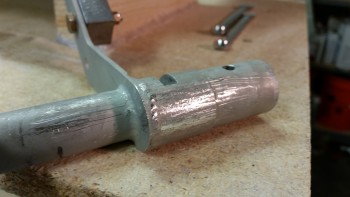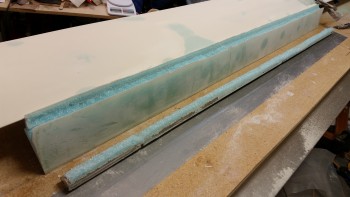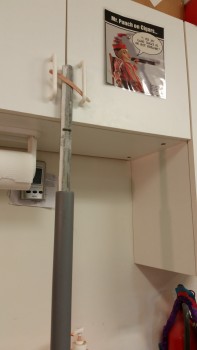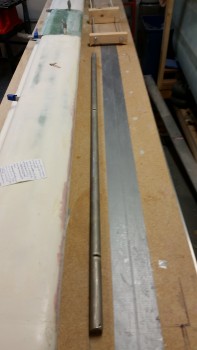After taking a long hard look at the left elevator I made the call to rebuild it. The plans say that you can sand the skin down to 1 ply of glass with no issues as long as the areas aren’t too big (around 2″ in diameter). I met this criteria, the weight was under control after the heavy sanding, but the skin felt just a little too soft in that there was just a bit of give in about 3 of the 5 thinly sanded spots. My gut told me that this was ok and met the “letter of the law,” but since I have a perfectly “perfect” elevator core from Eureka CNC on hand, my brain said the right thing to do was rebuild this sucker. I want to be clear, this wasn’t a decision borne of fear, but one of optimization. I simply want to be able to run this bird as fast as I want to, without worries yes, but the more complete the elevator skin is, then common sense dictates the less prone to structural failure if I do encounter any flutter.
So, I chose to rebuild.
Here is the left elevator when I started this evening.
I began by removing the torque tube offset on the inboard side.
And then I removed the outboard weight.
If you remember, a while back I had a “moment” as I was floxing the inboard elevator hinge bracket into the canard slot. I had some type of exotherm issue where it spit out a good portion of the flox onto the hinge, torque tube, etc. The flox even bridged between all these parts and the fishtail area of the canard TE. I was heading out to meet my buddy Rob, so if I hadn’t found this issue and cleaned it up my life would have been hell for a at least a few days.
Anyway, that incident left some flox on the elevator torque tube offset that I never really noticed until today. After I removed the installing torque offset, I heated it up with the heat gun on high and then scraped off the dried epoxy.
This was the result of my cleaning:
Below is a shot of the “clean” left elevator with all the “add-ons” removed.
Then, as I did with the right elevator, I checked the gaps for hinge slot spacing with the hinge pin and NC7’s installed.
After I got my hinge spacing set and spacers cut to size, I made my first cut to remove the skin along the top of elevator.
And then the next cut along the bottom of the elevator near the tube. I used my trusty Fein saw to make these cuts (BTW, in my shop Fein=Harbor Freight!)
I then extricated the elevator tube from the glass & foam of the now “old” elevator core.
I cleaned off the old foam & micro with my razor knife in the first round of elevator tube cleaning.
Then, just as with the right elevator tube, I dunked it in a PVC tube full of solution. Only this time I soaked it in acetone vs. white vinegar since I wanted to get this tube completely cleaned by evening’s end. I figured acetone would probably have a bit more of a “bite” to it.
While the elevator tube was soaking, I removed the canard from its mounts and cleaned the leftover Bondo off the mounts.
With the mounts clean (read: no scratching or gouging the top finish), I flipped the canard upside down. I was pleased that the Bondo blobs securing the canard to the mounts turned out to be pretty much in as inconspicuous places as I could possible get them.
If you look closely at the pics below, you can see that the Bondo is right on the line of the junction (or corner) where the bottom of the canard meets the fuselage. Clean up and noticeability in this area shouldn’t be too demanding.
I then took a long shot of the canard –bottom view– that clearly shows that I have a fair amount of work left on the bottom side of the canard as well.
After a couple of hours, I removed the elevator tube from the acetone for its final cleaning.
Note the NG30 assembly to F22 bulkhead clamp in the background for the upcoming nose build. I drilled and assembled this guy tonight.
Tomorrow I plan on sanding the elevator tube before Alodining it. If all goes well I should get the elevator foam core attached to the elevator tube and the bottom skin laid up.

















